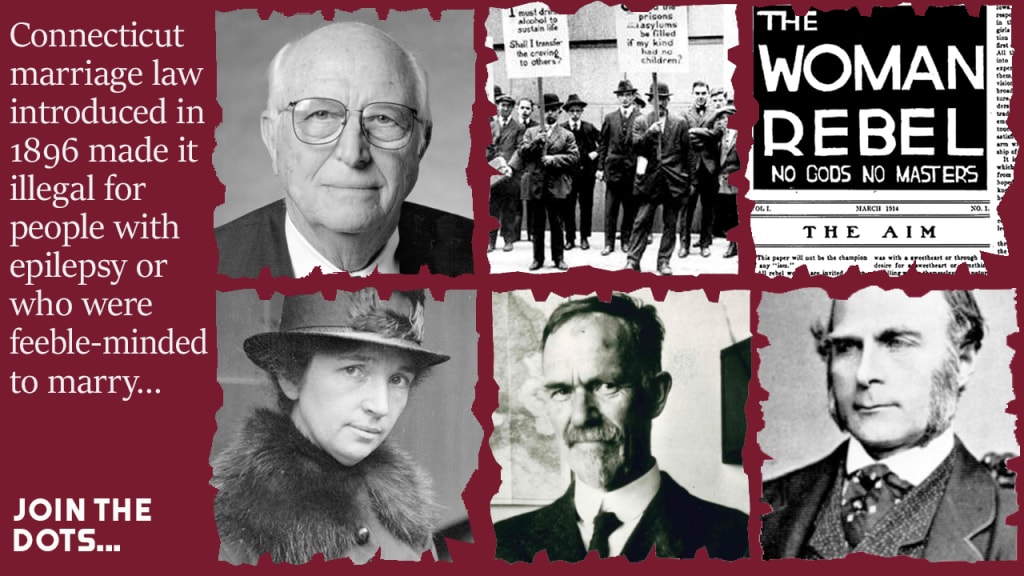'Covid' Ops: History of eugenics and sterilization
What lies beneath the Gates' foundation?

Once you start digging into what this “global pandemic” is all about and following the dots that spring up everywhere, it becomes very difficult to decide what road to follow next.
I’d read a little of Bill Gates’ links to Monsanto and its involvement in GM crops, but far from enough to come to any conclusions. So I set out yesterday to remedy that… and boy do those warning lights keep flashing the deeper you dig.
My trek through time took me to the generation before Gates’ father, William Henry Gates II, was born and the eugenics movement in the United States that sprang up from the scientific work of Czech Augustinian friar Gregor Mendel, widely regarded as the founder of the modern science of genetics.
Mendel died in 1884, aged 61, but his work was the source of much inspiration for British scholar Sir Francis Galton, who coined the term eugenics in his 1883 book, Inquiries into Human Faculty and Its Development. The word “eugenics” literally means “good creation” and comes from the writings of the ancient Greek philosopher Plato.
In the late 19th century Galton, whose cousin was Charles Darwin, sought to better mankind through the propagation of the British elite. His plan never really took hold in the UK, but in America it was widely embraced.
The movement received extensive funding from various corporate foundations, such as the Carnegie Institution, Rockefeller Foundation, and the Harriman railroad fortune, with a first point of reference appearing in 1890 when Brooklyn Institute of Arts and Sciences director Franklin Hooper and Eugene G Blackford started a summer programme for the education of college and high-school teachers studying zoology, botany, comparative anatomy and nature… known as The Biological Laboratory at Cold Spring Harbor, New York.
By 1904 eugenicist Charles Davenport had become director of the summer school and through his connections persuaded the Carnegie Institution in Washington to fund the Station for Experimental Evolution, a centre for the study of heredity based on the work of Mendel. Davenport left the University of Chicago in 1904 to become its full-time director.
But he wanted to expand the study of heredity in humans and in 1910 persuaded the widow of E H Harriman to endow a research facility dedicated to eugenics.
The Eugenics Record Office at Cold Spring Harbor, funded by Harriman and later by the Carnegie Institution, became a clearing house for the research data created by field workers in the growing eugenics movement. Davenport, its director, also maintained his roles at the Station for Experimental Evolution and The Biological Laboratory.
The purpose of the Eugenics Record Office was to track families and their genetic traits… its findings showing that most people considered unfit to procreate were immigrants, minorities or the poor.
But perhaps the first official appearance of eugenics in the US history books was the 1896 introduction of Connecticut marriage laws that made it illegal for people with epilepsy or who were “feeble-minded” to marry.
In 1903, the American Breeder’s Association became the first scientific organisation in the US to recognise Mendel’s work and to support eugenic research. The fifth annual meeting of the American Breeders Association was held during Farmers’ Week at the University of Missouri in January 1909. The meeting heralded the start of the American Breeders Magazine and provided the opportunity for Davenport to connect with Harry Laughlin, later to become a founder of the American Eugenics Society, resulting in a lifelong association between the two men. By 1914, the organisation had become the American Genetic Association and the magazine was renamed The Journal of Heredity.
Three years earlier, in 1911, Davenport and John Harvey Kellogg, of Kellogg cereal fame, had set up the Race Betterment Foundation and established a “pedigree registry”, with the foundation hosting national conferences on eugenics in 1914, 1915 and 1928.
At this point an American birth control and sex education activist Margaret Sanger became involved, publishing a series of articles for the New York Call.
In 1914 she issued a short-lived magazine, The Woman Rebel, and distributed a pamphlet, Family Limitation, advocating her views.
She was indicted for mailing materials advocating birth control, but the charges were dropped in 1916. Later that year she opened the first birth control clinic in the United States in Brooklyn.
She was arrested and charged with maintaining a “public nuisance” and in 1917 served 30 days in the Queens penitentiary. While she was serving time, the first issue of her periodical The Birth Control Review was published. Her sentencing and subsequent episodes of legal harassment helped to crystallise public opinion in favour of the birth control movement.
In 1921 Sanger founded the American Birth Control League, serving as its president until 1928. The league was one of the parent organisations of the Birth Control Federation of America, which in 1942 became the Planned Parenthood Federation of America, with Sanger as honorary chairman.
Sanger, who had travelled to Europe to study the issue of birth control there, also organised the first World Population Conference in Geneva in 1927, and she was the first president of the International Planned Parenthood Federation (founded 1953). Subsequently she took her campaign for birth control to Asian countries, especially India and Japan.
In 1926 the American Eugenics Society was established by Laughlin, Madison Grant, Henry Crampton, Irving Fisher and Henry F Osborn to promote eugenics education programmes for the US public. The body described eugenics as the study of improving the genetic composition of humans through controlled reproduction of different races and classes of people, with the group aiding smaller eugenic efforts such as the Galton Society in New York and Kellogg’s Race Betterment Foundation in Battle Creek, Michigan.
One of the American Eugenics Society’s members was Sanger, with other members having earlier participated in the establishment of the American Birth Control League.
Just a few months before the beginning of WWII with the US eugenics programmes almost 20 years old, Adolf Hitler’s Third Reich had already started to follow them to their logical conclusions, by murdering multiple thousands of the weak and helpless, whose handicaps disqualified them for a future in the Aryan utopia envisioned by the Nazis.
And in the United States, Sanger moved from promoting private means of “birth control” to avoid the consequences of promiscuity to setting up protocols to assist states with eliminating the “dysgenic horror story” of blacks who reproduced “carelessly and disastrously”.
New efforts in contraception in America, especially sterilization, would be promoted to discourage and perhaps eventually eliminate “the defective and diseased elements of humanity”.
So came about the “Negro Project”, backed by funding from the Rockefeller Foundation, of which historian George Grant wrote: “The program’s genocidal intentions were carefully camouflaged beneath several layers of condescending social service rhetoric and organizational expertise. Like the citizens of Hamelin, lured into captivity by the sweet serenades of the Pied Piper, all too many African Americans all across the country happily fell into step behind Margaret and the eugenic racists she had placed on her Negro Advisory Council.”
The Negro Advisory Council established clinics all over the South, distributing contraceptives to the “reckless and irresponsible swarming and spawning... diseased elements of humanity”. With the support of hand-picked black ministers and state public health officials, the slick propaganda literature of “planned parenthood” moved along smoothly.
But leaders of the American eugenics movement were becoming troubled that Hitler had tarnished the word “eugenics” but didn’t want to abandon the quest for thoroughbred humans, which Sanger herself touted. They simply chose new words to describe eugenics.
In 1942, the Birth Control Federation of America became the Planned Parenthood Federation of America.
Not satisfied with just community-based clinics, Planned Parenthood moved into the public schools in the 1980s, primarily in the inner-city minority neighbourhoods. But contraceptive offerings provided only one of the services promoted by Sanger. Sterilization of non-whites also lay at the centre of Planned Parenthood’s agenda and several states established pilot programmes for, primarily, minority victims.
California’s role began in 1909 and lasted for 70 years. At least 20,000 sterilizations in state institutions were performed during that time.
Today, the abortion industry has picked up where the forced sterilization programmes left off, but now with Supreme Court legal sanctions and sympathetic legislatures across the US. Many government schools and clinics promote the Planned Parenthood agenda, and Congress, with significant bi-partisan support, has included support for them in annual budgets.
Many sterilizations were forced and performed on minorities, with 33 states eventually allowing involuntary sterilization for whoever lawmakers deemed unworthy to procreate.
In the 1930s, the governor of Puerto Rico, Menendez Ramos, implemented sterilization programmes for Puerto Rican women. Ramos claimed the action was needed to battle rampant poverty and economic strife. At one point more than one-third were sterilized without informed consent, and poor Puerto Rican women were also used as guinea pigs to test birth control products.
According to a 1976 Government Accountability Office investigation, between 25 and 50 per cent of Native Americans were sterilized between 1970 and 1976. It’s thought some sterilizations happened without consent during other surgical procedures such as an appendectomy. In some cases, health care for living children was denied unless their mothers agreed to sterilization.
Today nearly all Downs Syndrome babies are terminated before they are born, as part of a public policy laid down by the US Supreme Court.
So, what’s all this got to do with Bill Gates? Well, in an interview in 2003 on Now with Bill Moyers, he was quite open about his father being a former head of Planned Parenthood, but finding any details about his involvement are extremely hard to come by, almost as if a chapter has been erased from the web.
We know William H Gates II was a prominent banker and a lawyer in Preston Gates & Ellis and that he presided over many bar associations and organisation boards but there’s very little about his service on the board of Planned Parenthood during the group’s infancy.
The company spread from beginnings in Cold Spring Harbor genetics and virology labs on Long Island and Berlin, to become one of the largest organisations in the US, with the Rockefeller-Bayar Co, BASF and Hoechst petrochemical-pharmaceutical consortium all being initial funders of the group.
In 1994 the William H Gates Foundation was formed, managed by Bill Gates’ father, and three years later, the Gates Library Foundation was created, later to become the Gates Learning Foundation to reflect its expansion into broader education efforts.
The Bill & Melinda Gates Foundation was established in 2000 through the merger of the two Gates foundations. Its original priorities were global health, education, libraries, and the Pacific Northwest. In 2006 the foundation reorganised to comprise global development, global health, and United States divisions (a global policy and development division was added in 2012).
Also in 2006, the investor and philanthropist Warren Buffett made a lifetime pledge to the foundation of Berkshire Hathaway stock valued at US$31 billion, with Gates announcing his plans to step down down from his position at Microsoft effective 31 July 2008 to devote his efforts full-time to the foundation.
So, that’s the origins of Gates’ foundation, population control very much a core facet. I still haven’t got to the Monsanto bit yet, I’m saving that for the next part to this story.
Interestingly the Cold Spring Harbor Laboratory, Planned Parenthood and the American Genetic Association are all still flourishing.
About the Creator
Steve Harrison
From Covid to the Ukraine and Gaza... nothing is as it seems in the world. Don't just accept the mainstream brainwashing, open your eyes to the bigger picture at the heart of these globalist agendas.
JOIN THE DOTS: http://wildaboutit.com






Comments
There are no comments for this story
Be the first to respond and start the conversation.